Abstract
The mechanism of postarrhythmic renal vasoconstriction was studied in 28 dogs anesthetized with pentobarbital sodium (30 mg/kg i.v.). Rapid atrial or ventricular pacing or induction of atrial fibrilation were used to produce at least 20% prompt decrease in cardiac output and mean arterial blood pressure. Return to control cardiac output and blood pressure occurred within 3 minutes after cessation of the arrhythmia, but renal blood flow remained significantly decreased (26%) with gradual recovery by 17.7 +/- 6.6 min. Infusion of phentolamine (0.25 mg/min) into the renal artery, intravenous hexamethonium (l mg/kg), adrenal demedullation, or cooling the cervical vagi prevented postarrhythmic renal vasoconstriction. In contrast, renal denervation, intravenous bretylium (10 mg/kg), intravenous atropine (0.5 mg/kg) or intrarenal SQ 20881 (0.20 mg/min) has no effect on postarrhythmic renal vasoconstriction. Intravenous propranolol (0.5 mg/kg) intensified postarrhythmic renal vasoconstriction. These data suggested that the postarrhythmic renal vasoconstrictive response required intact vagi and was due to alpha adrenergic stimulation by adrenal catecholamines. However, femoral arterial catecholamine levels were not elevated above control during postarrhythmic renal vasoconstriction. We therefore sought local vascular pathways by which catecholamines might reach the kidneys. An adrenorenal vascular network was found in each dog. Collection of catecholamines from these vessels during postarrhythmic renal vasoconstriction in six dogs revealed catecholamine concentrations threefold higher than simultaneously collected femoral arterial catecholamines levels. Because ligation of these vessels abolished postarrhythmic renal vasoconstriction in each dog, we conclude that postarrhythmic renal vasconstriction is due to adrenal catecholamines reaching the kidneys through an adreno-renal vascular network and that the response requires intact vagi.
Full text
PDF
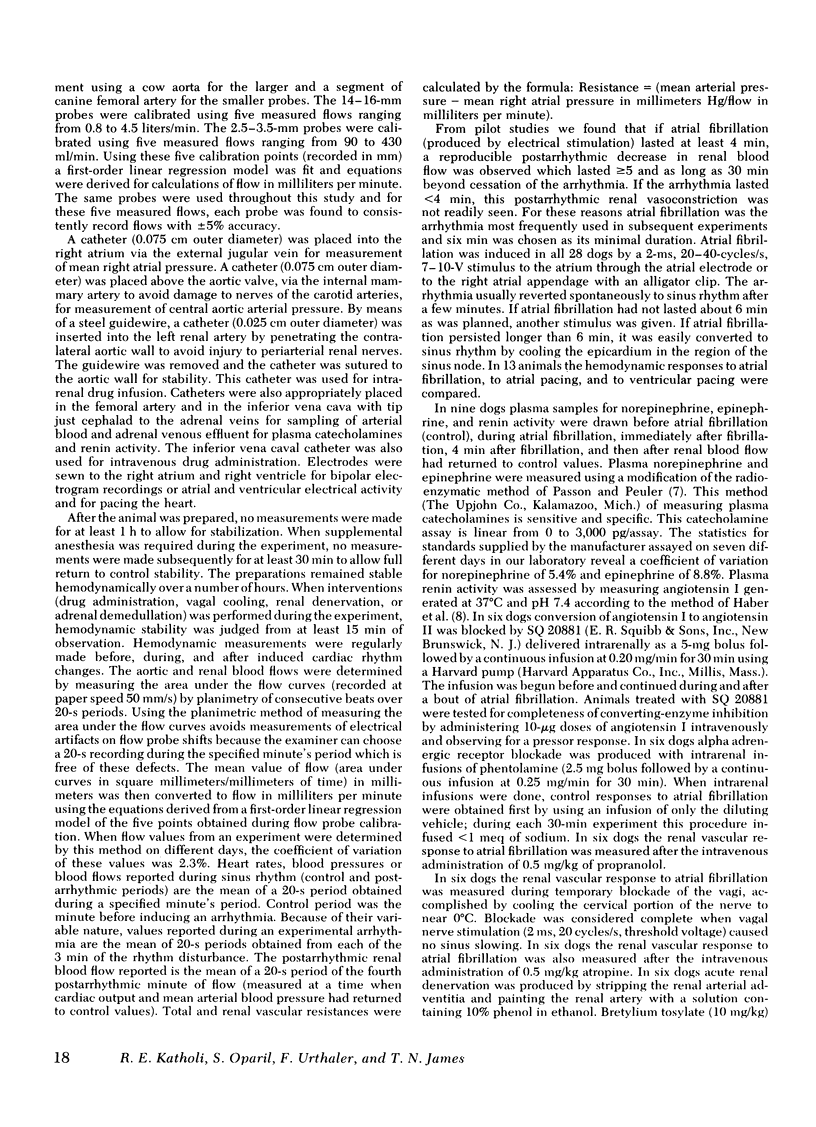
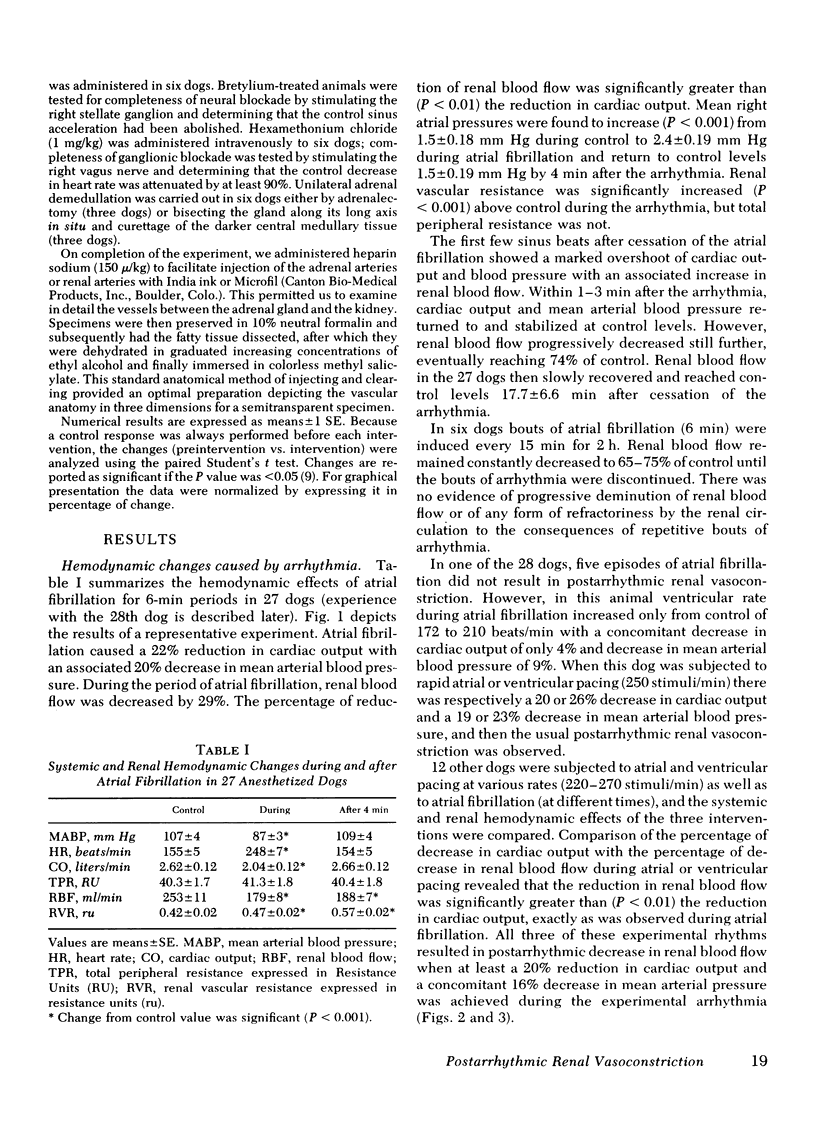
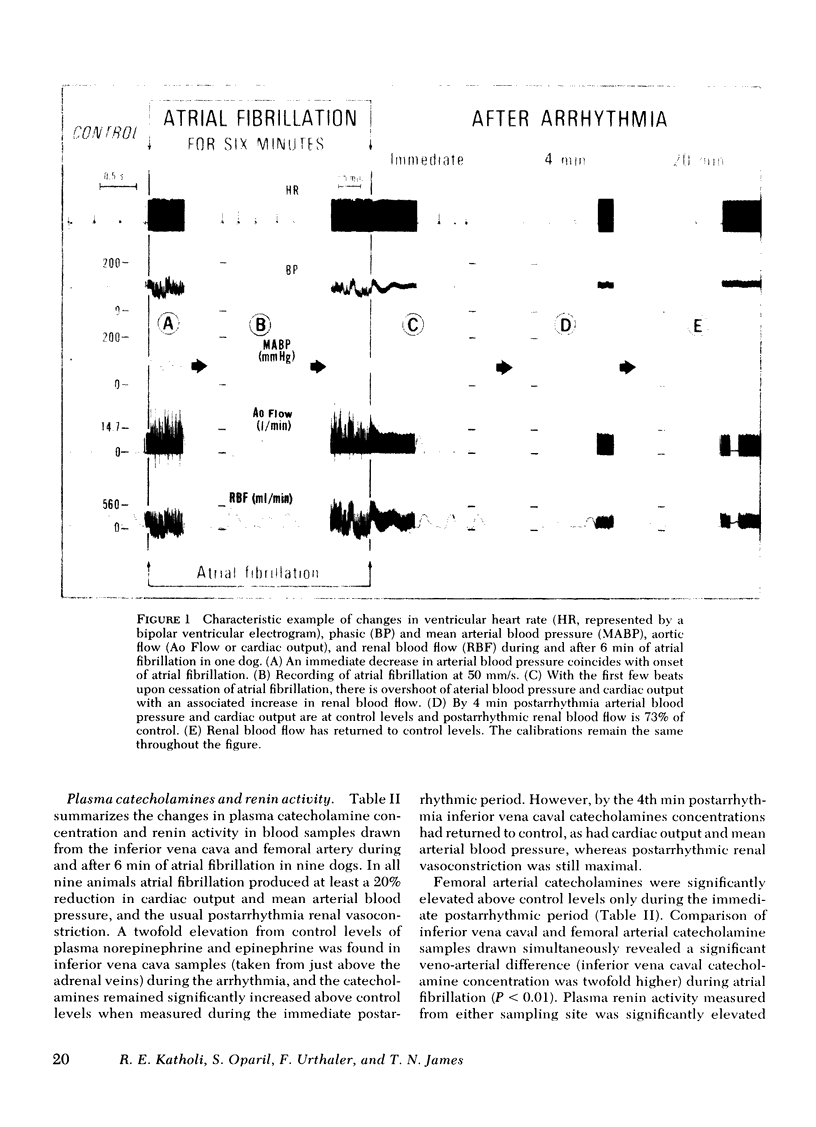
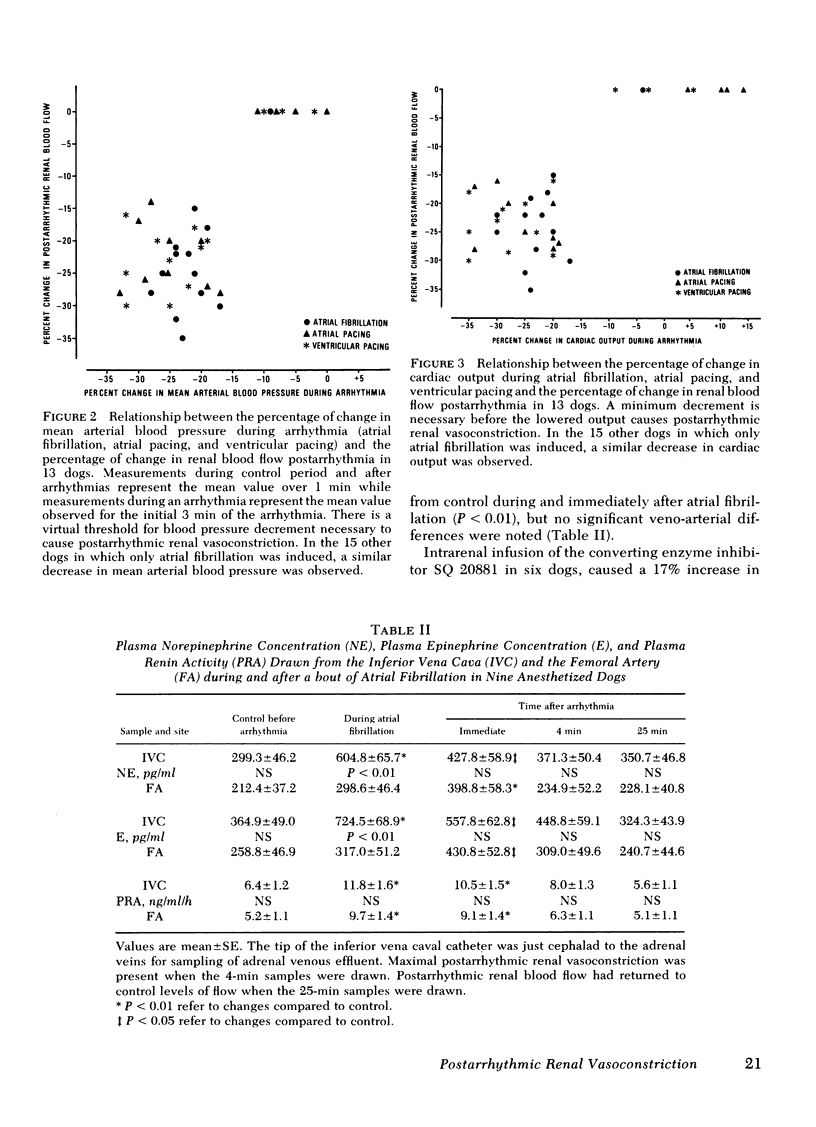
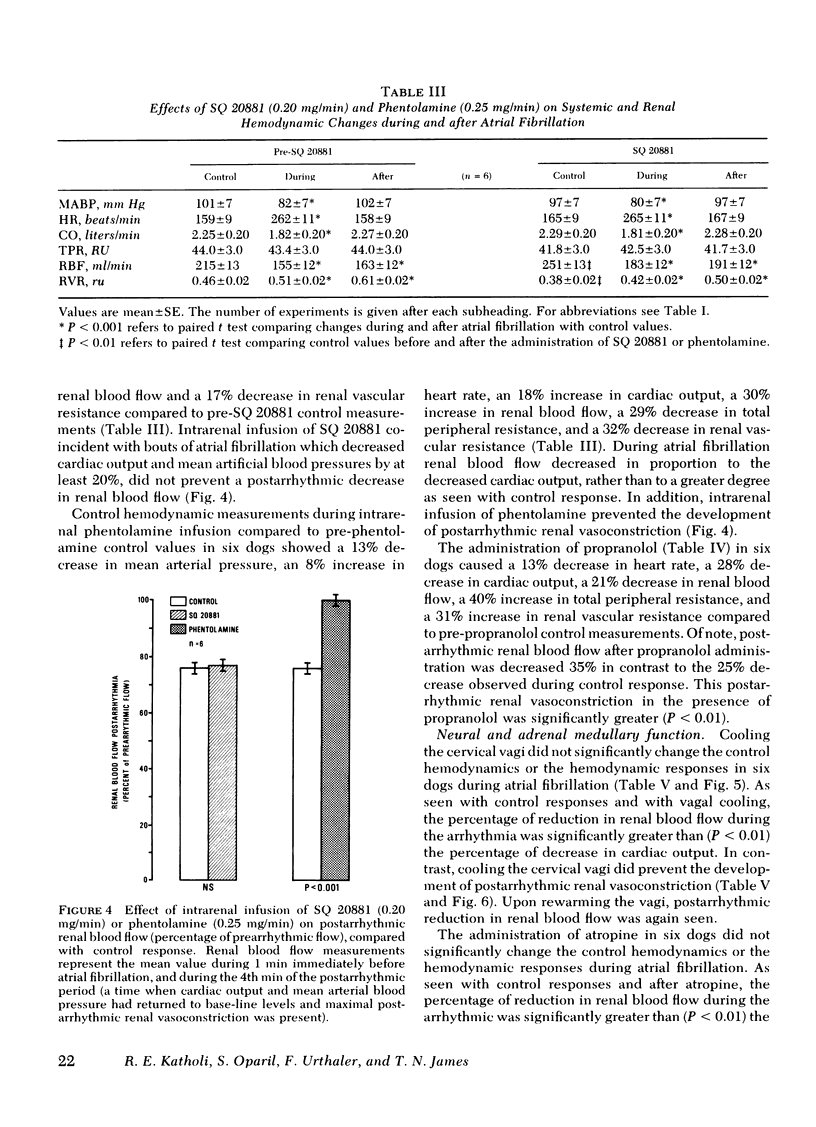
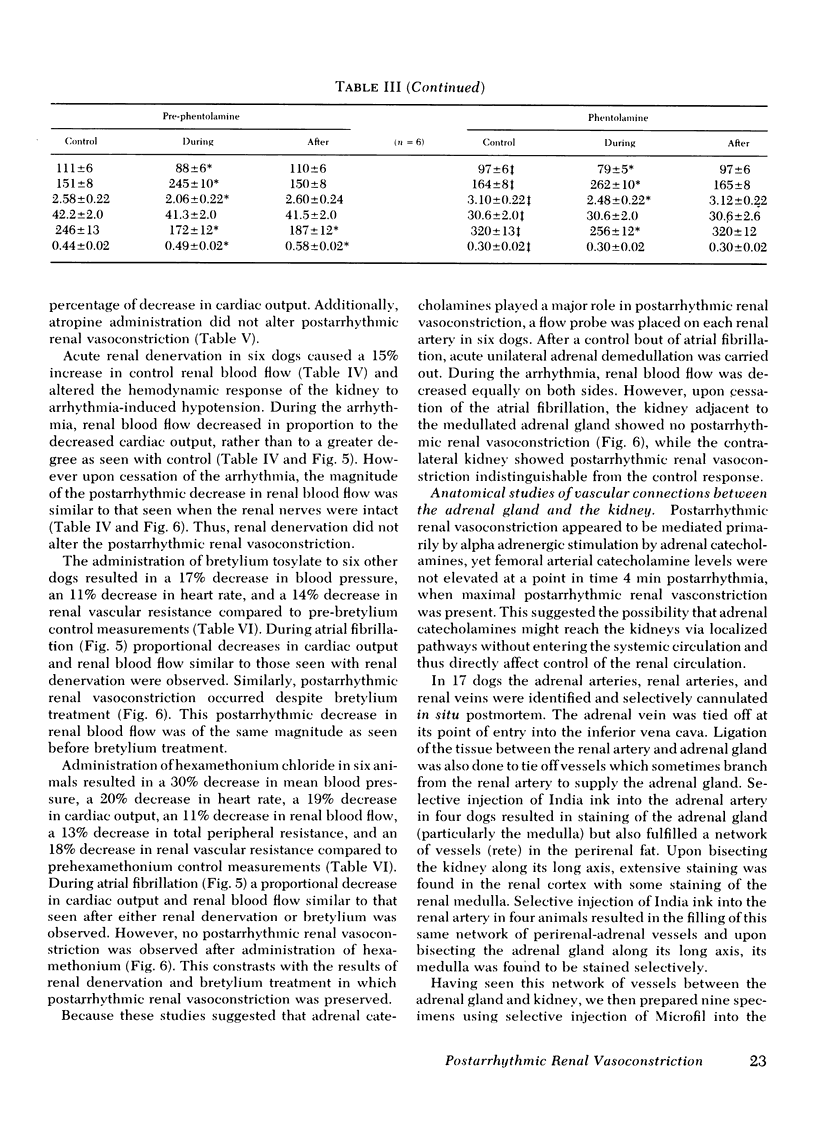


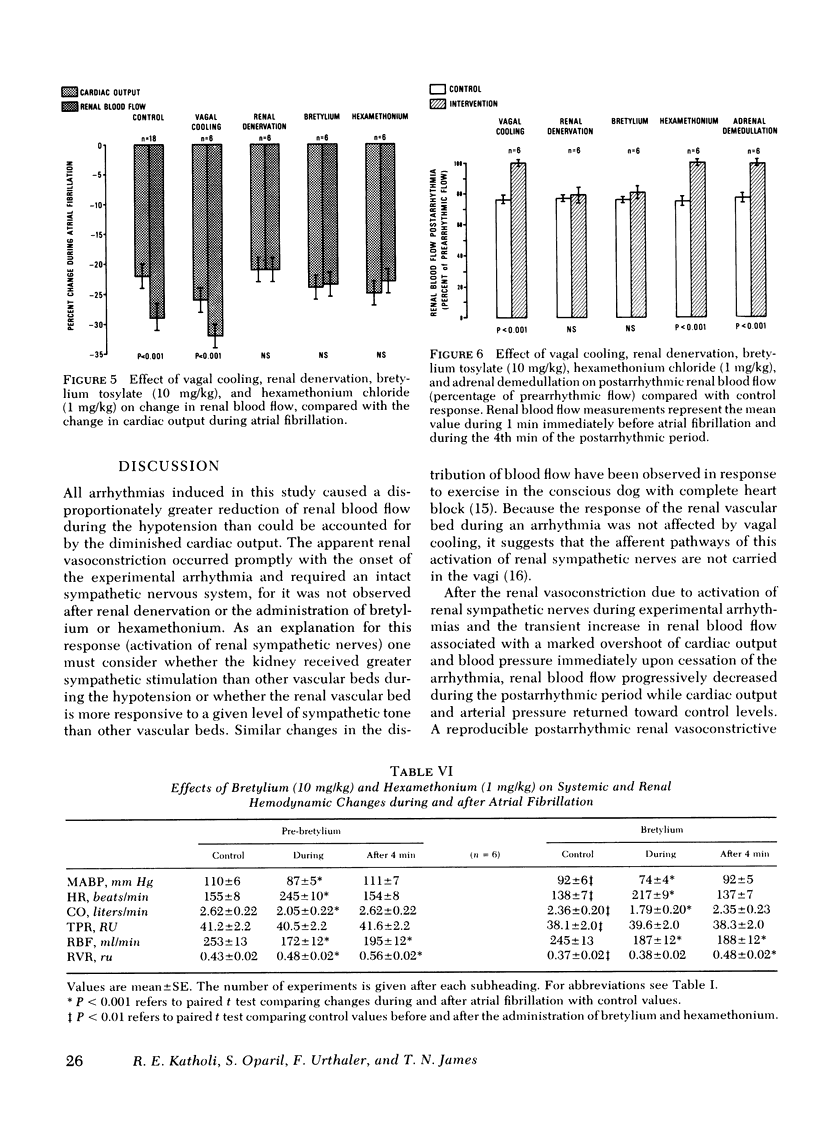
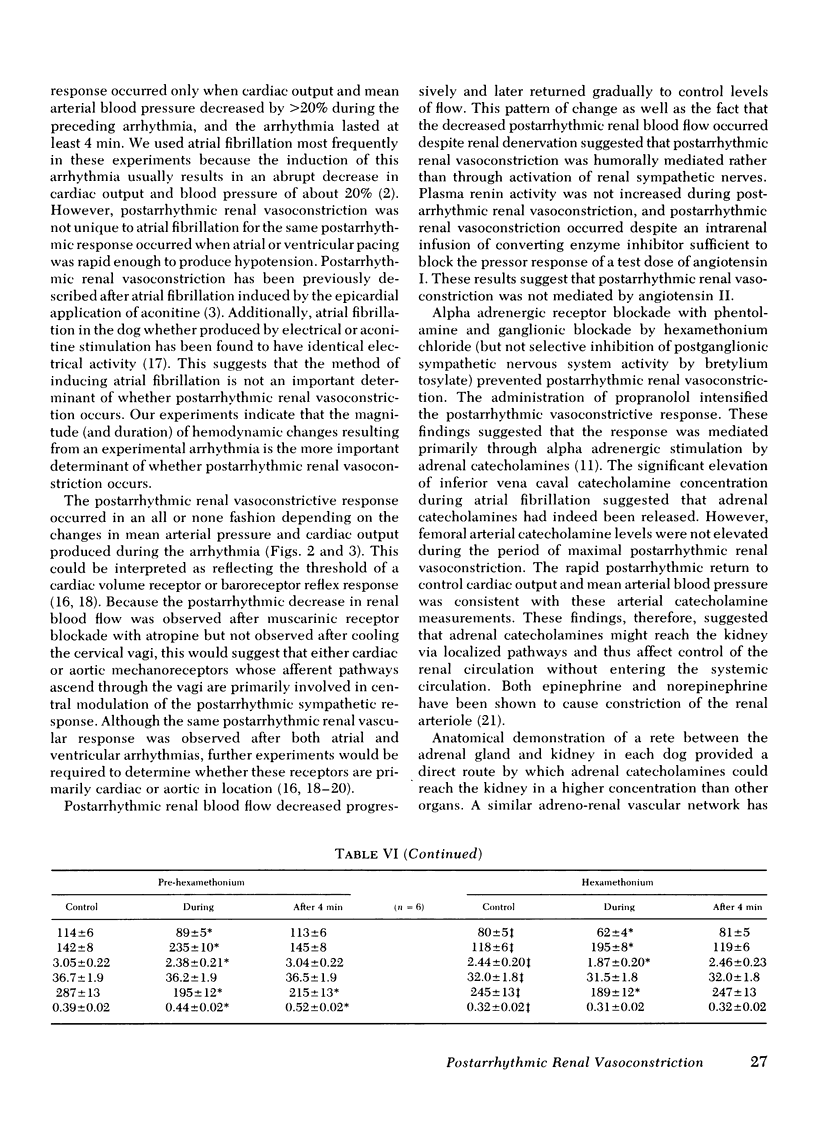

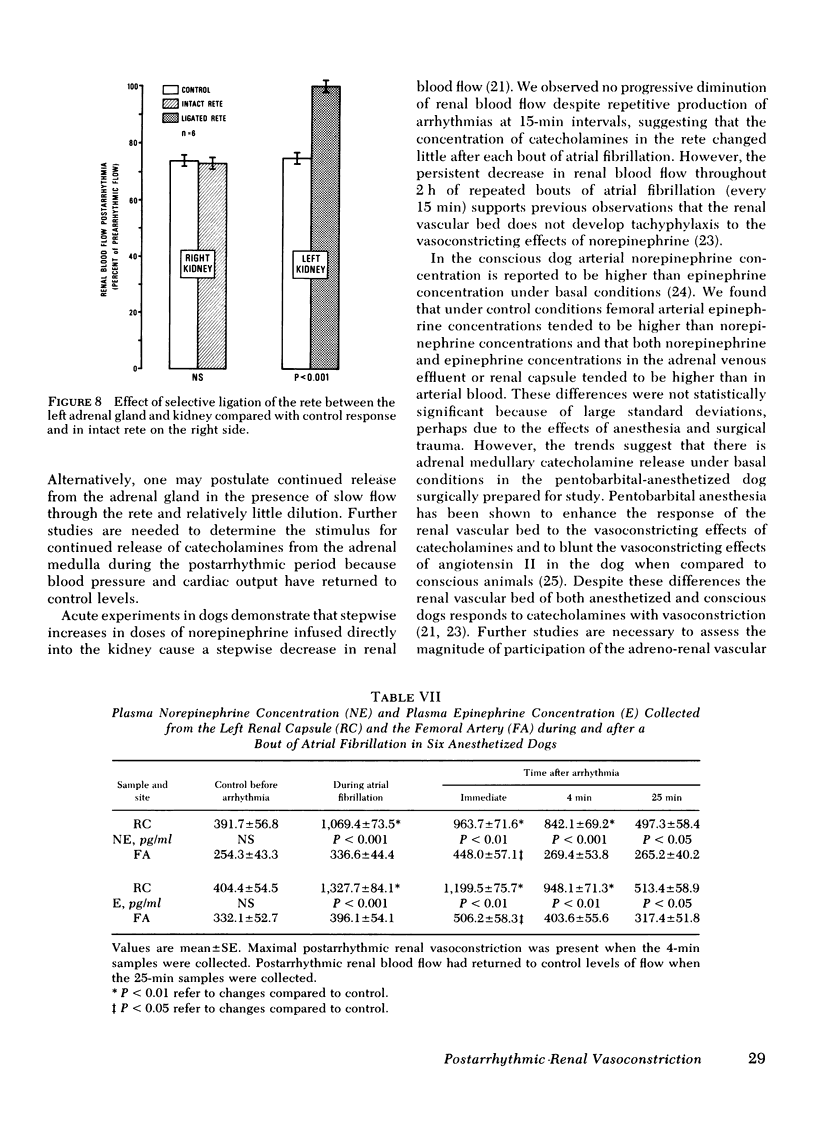
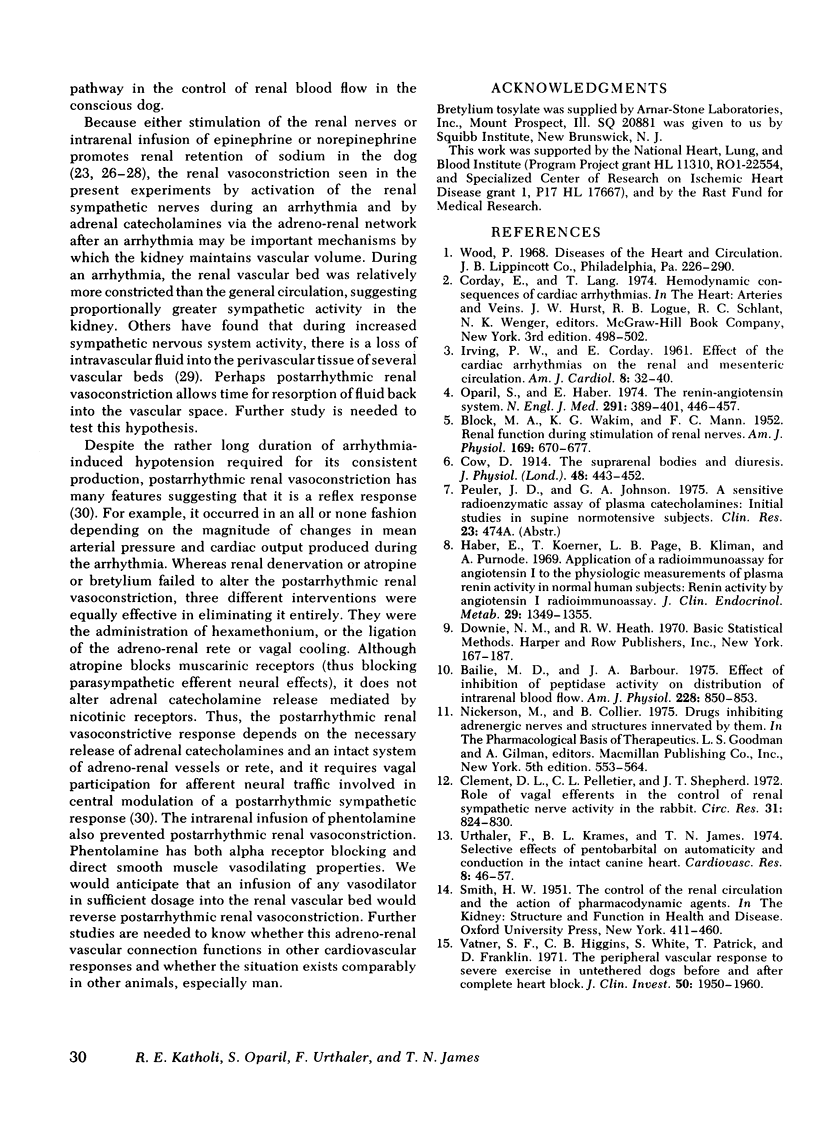
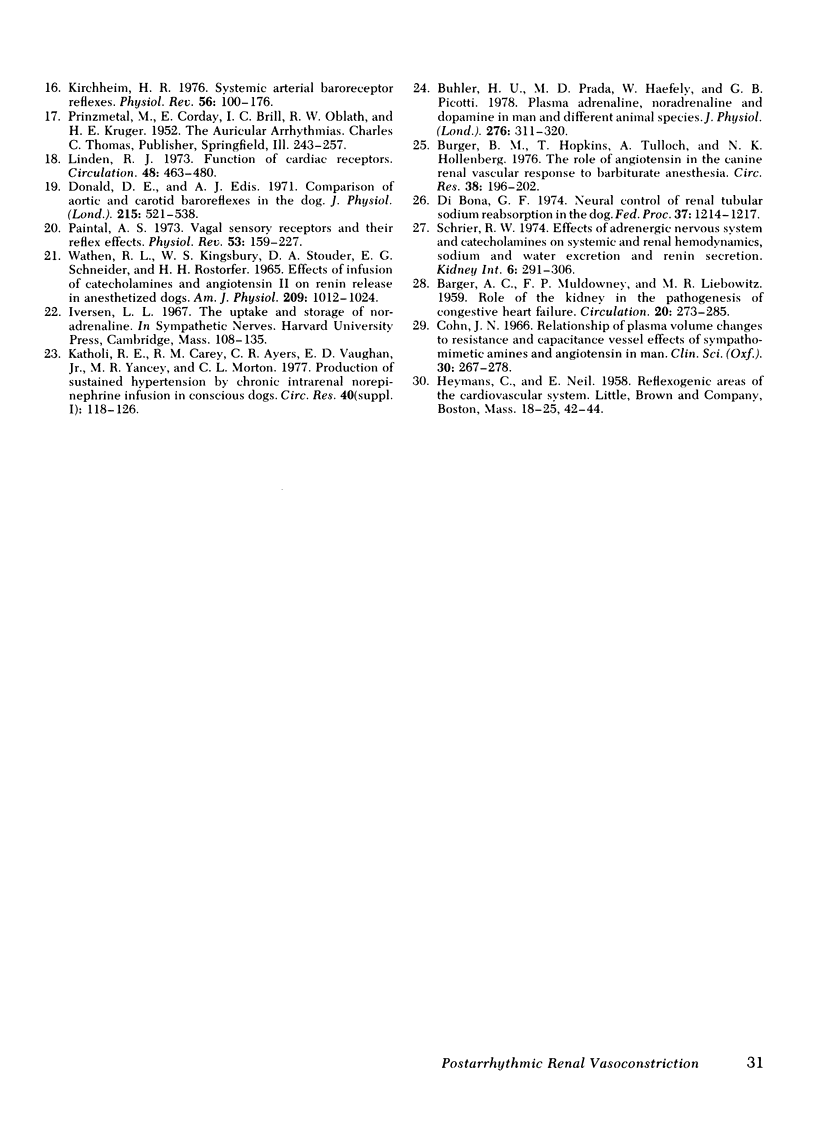
Images in this article
Selected References
These references are in PubMed. This may not be the complete list of references from this article.
- BARGER A. C., MULDOWNEY F. P., LIEBOWITZ M. R. Role of the kidney in the pathogenesis of congestive heart failure. Circulation. 1959 Aug;20(2):273–285. doi: 10.1161/01.cir.20.2.273. [DOI] [PubMed] [Google Scholar]
- BLOCK M. A., WAKIM K. G., MANN F. C. Renal function during stimulation of renal nerves. Am J Physiol. 1952 Jun;169(3):670–677. doi: 10.1152/ajplegacy.1952.169.3.670. [DOI] [PubMed] [Google Scholar]
- Bailie M. D., Barbour J. A. Effect of inhibition of peptidase activity on distribution of intrarenal blood flow. Am J Physiol. 1975 Mar;228(3):850–853. doi: 10.1152/ajplegacy.1975.228.3.850. [DOI] [PubMed] [Google Scholar]
- Burger B. M., Hopkins T., Tulloch A., Hollenberg N. K. The role of angiotensin in the canine renal vascular response to barbiturate anesthesia. Circ Res. 1976 Mar;38(3):196–202. doi: 10.1161/01.res.38.3.196. [DOI] [PubMed] [Google Scholar]
- Bühler H. U., da Prada M., Haefely W., Picotti G. B. Plasma adrenaline, noradrenaline and dopamine in man and different animal species. J Physiol. 1978 Mar;276:311–320. doi: 10.1113/jphysiol.1978.sp012235. [DOI] [PMC free article] [PubMed] [Google Scholar]
- Clement D. L., Pelletier C. L., Shepherd J. T. Role of vagal afferents in the control of renal sympathetic nerve activity in the rabbit. Circ Res. 1972 Dec;31(6):824–830. doi: 10.1161/01.res.31.6.824. [DOI] [PubMed] [Google Scholar]
- Cohn J. N. Relationship of plasma volume changes to resistance and capacitance vessel effects of sympathomimetic amines and angiotensin in man. Clin Sci. 1966 Apr;30(2):267–278. [PubMed] [Google Scholar]
- Cow D. The suprarenal bodies and diuresis. J Physiol. 1914 Sep 8;48(5):443–452. doi: 10.1113/jphysiol.1914.sp001674. [DOI] [PMC free article] [PubMed] [Google Scholar]
- Donald D. E., Edis A. J. Comparison of aortic and carotid baroreflexes in the dog. J Physiol. 1971 Jun;215(2):521–538. doi: 10.1113/jphysiol.1971.sp009483. [DOI] [PMC free article] [PubMed] [Google Scholar]
- Haber E., Koerner T., Page L. B., Kliman B., Purnode A. Application of a radioimmunoassay for angiotensin I to the physiologic measurements of plasma renin activity in normal human subjects. J Clin Endocrinol Metab. 1969 Oct;29(10):1349–1355. doi: 10.1210/jcem-29-10-1349. [DOI] [PubMed] [Google Scholar]
- IRVING D. W., CORDAY E. Effect of the cardiac arrhythmias on the renal and mesenteric circulations. Am J Cardiol. 1961 Jul;8:32–40. doi: 10.1016/0002-9149(61)90176-x. [DOI] [PubMed] [Google Scholar]
- Kirchheim H. R. Systemic arterial baroreceptor reflexes. Physiol Rev. 1976 Jan;56(1):100–177. doi: 10.1152/physrev.1976.56.1.100. [DOI] [PubMed] [Google Scholar]
- Linden R. J. Function of cardiac receptors. Circulation. 1973 Sep;48(3):463–480. doi: 10.1161/01.cir.48.3.463. [DOI] [PubMed] [Google Scholar]
- Oparil S., Haber E. The renin-angiotensin system (second of two parts). N Engl J Med. 1974 Aug 29;291(9):446–457. doi: 10.1056/NEJM197408292910905. [DOI] [PubMed] [Google Scholar]
- Paintal A. S. Vagal sensory receptors and their reflex effects. Physiol Rev. 1973 Jan;53(1):159–227. doi: 10.1152/physrev.1973.53.1.159. [DOI] [PubMed] [Google Scholar]
- Schrier R. W. Effects of adrenergic nervous system and catecholamines on systemic and renal hemodynamics, sodium and water excretion and renin secretion. Kidney Int. 1974 Nov;6(5):291–306. doi: 10.1038/ki.1974.115. [DOI] [PubMed] [Google Scholar]
- Urthaler F., Krames B. L., James T. N. Selective effects of pentobarbital on automaticity and conduction in the intact canine heart. Cardiovasc Res. 1974 Jan;8(1):46–57. doi: 10.1093/cvr/8.1.46. [DOI] [PubMed] [Google Scholar]
- Vatner S. F., Higgins C. B., White S., Patrick T., Franklin D. The peripheral vascular response to severe exercise in untethered dogs before and after complete heart block. J Clin Invest. 1971 Sep;50(9):1950–1960. doi: 10.1172/JCI106687. [DOI] [PMC free article] [PubMed] [Google Scholar]
- Wathen R. L., Kingsbury W. S., Stouder D. A., Schneider E. G., Rostorfer H. H. Effects of infusion of catecholamines and angiotensin II on renin release in anesthetized dogs. Am J Physiol. 1965 Nov;209(5):1012–1024. doi: 10.1152/ajplegacy.1965.209.5.1012. [DOI] [PubMed] [Google Scholar]




